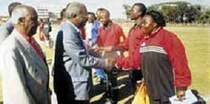Phase 5: Act Together
 Before this stage in the community mobilization process, you should have developed with the community various strategies and an action plan to address the health issue. During this stage in the Community Action Cycle, your team should assist the community to implement the action plan.
Before this stage in the community mobilization process, you should have developed with the community various strategies and an action plan to address the health issue. During this stage in the Community Action Cycle, your team should assist the community to implement the action plan.
STEP 1: Define your team's role in accompanying community action
In the community mobilization process, there are many possible roles the CM program team can play. CM program teams often end up assuming different roles at different stages of the process as the community's needs and capacity change. How a team perceives its role influences the way team members and community members relate to each other. A common source of conflict between communities and external organizations is their differing perspectives on the roles each entity is expected to play. You will need to continually review your role as the various steps of this phase unfold and ask yourselves whether you are creating or reinforcing dependency or fostering autonomy.STEP 2: Strengthen the community's capacity to carry out its action plan
Now it's time to determine whether and how your team can help community groups strengthen their abilities or help identify other individuals and organizations that would assist. The kind of assistance and expertise the community will need to increase its capacity vis-à-vis its action plan will depend on what that plan consists of.Once you and your team have a sense of what skills and knowledge the community may need to carry out the action plan, you will have to answer three related questions: (1) whether you will provide the necessary assistance and, if so, (2) how much and (3) what kind.
STEP 3: Monitor community progress
Monitoring during the "act together" phase and throughout the Community Action Cycle is carried out by various actors on several levels using a combination of formal and informal systems, methods and tools. The following general monitoring questions are appropriate for any group:- What is our goal? What are our desired results?
- What indicators do we use to judge our progress, success or failure?
- How do we currently assess how we are doing related to this goal and our desired results? What formal and informal monitoring processes currently exist to share observations about progress?
- What do we want to monitor that we currently do not monitor and how will we do this? What kind of tool and/or process do we need to implement?
Individuals and families monitor their personal health progress, noting how often they are sick and how much they spend on health and illness, and by using individual and family level tools such as growth monitoring charts, vaccination cards, family wall charts, medical records and others.
Community groups and organizations monitor progress on action plans, including whether they are carrying out what they planned and how their efforts are affecting health and other desired outcomes. Monitoring only the activities is not sufficient; to ensure that activities are contributing to positive changes in health, groups also need to monitor health indicators related to the health goal.
The CM program team monitors the overall program, including progress on health, community capacity and process indicators and the team's performance to inform teambuilding and program learning. In addition to monitoring change over time, you should also monitor the types of assistance that community groups may need in the future and prepare your team to be able to provide this assistance or identify other possible sources of help if you cannot, or choose not to, provide the assistance yourself.
Donors or other stakeholders monitor results to account for their investments and inform future decision-making. Your team should make sure to understand what the donors want to see in the reports and how they want to see it.
STEP 4: Problem-solve, trouble shoot, advise and mediate conflicts
In spite of the best planning, forethought and intentions, things do not always proceed smoothly. Good monitoring systems and regular communication will help to alert participants' to existing or potential problems.Every culture has developed strategies to prevent, avoid and resolve conflicts. Some strategies, while they may resolve conflict, can also create ongoing negative feelings and resentment. These types of strategies can usually be characterized as "win/lose" strategies. "Win/win" strategies more often result in better long-term relationships. It can be helpful to discuss with community groups how they have dealt with differences of opinion and conflict in the past, the results of these strategies and the differences between win/lose and win/win approaches to conflict resolution.
Now that you have assisted the community in implementing the action plan, you are ready to evaluate the CM program.

